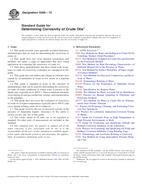Wir benötigen Ihre Einwilligung zur Verwendung der einzelnen Daten, damit Sie unter anderem Informationen zu Ihren Interessen einsehen können. Klicken Sie auf "OK", um Ihre Zustimmung zu erteilen.
ASTM D5853-11
Standard Test Method for Pour Point of Crude Oils
Automatische name übersetzung:
Standard Test Method for Pour Point von Rohölen
NORM herausgegeben am 1.6.2011
Informationen über die Norm:
Bezeichnung normen: ASTM D5853-11
Anmerkung: UNGÜLTIG
Ausgabedatum normen: 1.6.2011
SKU: NS-32797
Zahl der Seiten: 8
Gewicht ca.: 24 g (0.05 Pfund)
Land: Amerikanische technische Norm
Kategorie: Technische Normen ASTM
Kategorie - ähnliche Normen:
Die Annotation des Normtextes ASTM D5853-11 :
Keywords:
cold flow, crude oil, pour point: Cold flow, Crude petroleum products, Maximum pour point temperature, Minimum pour point temperature, Pour point--petroleum products, ICS Number Code 75.040 (Crude petroleum)
Ergänzende Informationen
| Significance and Use | ||||||||||||||
|
The pour point of a crude oil is an index of the lowest temperature of handleability for certain applications. This is the only pour point method specifically designed for crude oils. The maximum and minimum pour point temperatures provide a temperature window where a crude oil, depending on its thermal history, might appear in the liquid as well as the solid state. The test method can be used to supplement other measurements of cold flow behavior. It is especially useful for the screening of the effect of wax interaction modifiers on the flow behavior of crude oils. |
||||||||||||||
| 1. Scope | ||||||||||||||
|
1.1 This test method covers two procedures for the determination of the pour point temperatures of crude oils down to −36°C. Procedure A provides a measure of the maximum (upper) pour point temperature and is described in 9.1. Procedure B provides a measure of the minimum (lower) pour point temperature and is described in 9.2. 1.2 The use of this test method is limited to use for crude oils. Pour point temperatures of other petroleum products can be determined by Test Method D97. 1.3 The values stated in SI units are to be regarded as standard. No other units of measurement are included in this standard. 1.4 WARNING—Mercury has been designated by many regulatory agencies as a hazardous material that can cause central nervous system, kidney and liver damage. Mercury, or its vapor, may be hazardous to health and corrosive to materials. Caution should be taken when handling mercury and mercury containing products. See the applicable product Material Safety Data Sheet (MSDS) for details and EPA’s websitehttp://www.epa.gov/mercury/faq.htmfor additional information. Users should be aware that selling mercury and/or mercury containing products into your state or country may be prohibited by law. 1.5 This standard does not purport to address all of the safety concerns, if any, associated with its use. It is the responsibility of the user of this standard to establish appropriate safety and health practices and determine the applicability of regulatory limitations prior to use. For specific hazard statements, see Section 7. |
||||||||||||||
| 2. Referenced Documents | ||||||||||||||
|
Ähnliche Normen:
Historisch
1.5.2010
Historisch
1.1.2011
Historisch
1.7.2011
Historisch
1.5.2013
Historisch
1.12.2013
Historisch
1.9.2010
Empfehlungen:
Aktualisierung der technischen Normen
Wollen Sie sich sicher sein, dass Sie nur die gültigen technischen Normen verwenden?
Wir bieten Ihnen eine Lösung, die Ihnen eine Monatsübersicht über die Aktualität der von Ihnen angewandten Normen sicher stellt.
Brauchen Sie mehr Informationen? Sehen Sie sich diese Seite an.



 ASTM D7623-10
ASTM D7623-10 ASTM D7691-11e1
ASTM D7691-11e1 ASTM D7740-11
ASTM D7740-11 ASTM D7829-13e1
ASTM D7829-13e1 ASTM D7900-13e1
ASTM D7900-13e1 ASTM G205-10
ASTM G205-10
 Cookies
Cookies
